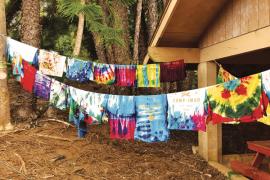Since moving to Montana from Pennsylvania several years ago, I’ve become much more attuned to the threat of wildfires, and have begun to learn more about what can be done to safeguard the people inside structures and limit damage at the same time. Our home is now at the very edge of the service area for a fine volunteer fire department, but there are surely limits to how quickly they can respond. Just last October, fire took our neighbors’ home, and it reminded us that living on the prairie has hazards and risks along with the wonders it brings.
One safety element that’s come to the fire forefront in the past decade is building sprinkler systems. In the early 2000s, Pennsylvania adopted its first statewide building code, and that threw the camp community into a giant tailspin. Building sprinklers were the hot button issue across the state. Many camps endured the expense and complication of installing water storage tanks, pumps, and sprinklers because local code officials were only aware of one way to suppress fire, and that used automatic sprinklers. Over time, officials have become more familiar with approaches like fire-retardant interior construction, integrated alarms, and short routes to adequate exits, deriving the idea that shortening evacuation time was the real goal of suppressing a fire that started inside. That discussion spread into a related topic: What about fires that would burn from the outside? Sprinklers provide no protection at all for that scenario. Whether the source of an out-of-control fire that threatens your facility began as a lightning strike or a campfire, the damage is the same. There are a number of approaches to fire safety, and most of these are contained within, or are ancillary to, the building code in place in your area. Learning about those methods and approaches is just smart stewardship, even where camp is “out of the jurisdiction” of the nearest building official.
Planning exterior building improvements to resist fire damage just makes good operational and financial sense. But with terms like “ignition resistant,” “Class A rating,” “noncombustible,” and so on, where do you begin? The hardest part may be learning the terminology and recognizing that states and provinces may have adopted slightly different definitions for the same terms. These region-specific definitions may prohibit certain products where other jurisdictions allow them. While your very best bet is to get help from a competent local architect to assist you, it’s completely up to you to become an informed client and customer. As a free starting point, begin with your local building code official. He or she can point you to the correct set of definitions and should be able to help you sort through the terms as well as the requirements for your area. For now, though, let’s look at some terms that play a role in a product’s response to fire as defined by the National Fire Protection Association (NFPA) Standard 1144. This organization develops the source of the fire codes for everybody else, so while these are general, they provide a consistent beginning point.
Fire resistive is a broad term for a style of construction that is designed to provide “reasonable protection against fire.” That is, a combination of products and their assembly/connection methods to reduce the spread of a fire on a structure. Consider, for example, a porch or deck that surrounds a cabin. They’re usually constructed of wood, but may also be from manufactured products including plastics. While I have long been a fan of composite materials’ low maintenance, no splinters, and long wear, composites are usually made from plastics, which include flammable petrochemicals and hydrocarbons. Decks and porches, then, can act like wicks to ignite the building they serve. Fire resistive construction in this case may permit wood or composite decks around a concrete building, which itself will not burn. (If you think I’m kidding about concrete buildings, take a look at the innovations from EverLog Systems of Missoula, Montana!) In this context, you could say fire resistive construction “discourages” the spread of a fire.
Noncombustible materials will not ignite, burn, or add appreciable heat to an ambient fire. Consider again the EverLog product just mentioned. As it is made from concrete and reinforced with glass fibers, there are no materials that will burn. It is noncombustible.
Fire retardant materials have been tested and are less susceptible to burning. For example, there are wood products, including siding, shakes, and roofing, which have been chemically treated to resist catching fire better than identical products that have not been treated.
One final point in this is worth your consideration as well. Steel (as siding or roofing) is noncombustible. However, it conducts heat very well. So, while an extended exposure to fire (such as from a burning deck or stack of firewood alongside the building) may not burn the siding, the heat is transferred easily to the construction underneath. Those materials may ignite long before the siding even shows signs of warping. The point here is that simply wrapping a building in a noncombustible product is no more guarantee for your building not burning than wrapping a potato in aluminum foil, throwing it in a campfire, and expecting it to stay raw. Fire resistant construction is an assembly of layers that work together to resist damaging heat transfer.
What about camp property overall? What can be done to protect your guests and capital investment? The NFPA, in cooperation with several federal agencies, has developed “Firewise USA,” an educational program on how to adapt to living with wildfire. Although it’s focused primarily on residential occupants, its principles apply to commercial and institutional situations like camps. One particularly relevant section talks about the most common means of building ignition by wildfire, which is windblown embers (“the ember threat”). These are burning pieces of wood or debris that become windborne. These can travel more than a mile from the active burn site and ignite another fire without a direct spread. The Firewise site describes three Home Ignition Zones (HIZ) surrounding a structure that are vulnerable to the ember threat and what can be done to minimize risk of catastrophic fire based on those zones. In the “immediate zone” (zero to five feet), they recommend:
- Clear roofs and gutters of dead leaves and dry debris.
- Repair roofing and replace missing tiles or shingles to prevent embers from entering.
- Install one-eighth-inch screen on eave and attic vents to reduce the size and number of embers that may enter.
- Move flammables out of the zone altogether. Those include dry mulch (many southern camps use ever-present pine straw for mulch), piles of firewood, and any other materials that will burn around or under the building, deck, or porch. Many camps store siding, decking, and other lumber in those spaces because it’s relatively dry and easily accessible for quick repairs. If it is indeed “dry enough,” chances are that those materials are building kindling queued up for a really big problem.
The next HIZ is the “intermediate zone” (five feet to 30 feet). Firewise USA provides recommendations concerning tree spacing, pruning, and tree placement planning such that when mature the tree crown is not closer than ten feet to the structure.
The most distant HIZ is the “extended zone” (30 feet to 100 feet), which is not intended to eliminate an approaching fire but to interrupt the fire’s path, keeping the flames lower to the ground and smaller (National Fire Protection Agency, 2018).
Dovetailing with the HIZ methodology, the final layer of protection is fire planning. As a Boy Scout, one of the first things we did to set up camp was to find the water supply and fill fire cans. In a cabin or village setting, careful and consistent staging of Indian Packs is certainly an improvement over that. But thinking even larger, have local fire department personnel ever been invited to a tour of camp? Do they have a large-scale map of all the camp structures and sites and are the roads accessible to the size and type of equipment they would bring? Can they get into and out of the draw point on your lake or pond without getting stuck? How do your cabins get electrical power — underground service, or perhaps there’s pump wire strung from tree to tree, which would be a hazard to a fire fighter on scene, especially after dark? You’ve likely given a tour to the emergency medical responders, but their ambulance or rescue vehicle can get into (and out of) many places that a pumper truck cannot. All local emergency personnel should be familiar with your property so they can help if the need arises, but the fire department has pretty special requirements if they’re going to be effective and as safe as possible in an emergency.
By planning to minimize the fire risk to your buildings and property, you’re well on the road to ensuring your guests’ safety at the same time. Much like a parachute you hope to never need but may only get one chance to use, planning for the worst is really the only prudent approach. While all of this sounds pretty simple and seems to be just common sense, every site is unique. Each site needs its own plan. If you have access to professionals with insight and knowledge about this, engage them! But when it comes down to it, the people who know camp best are the ones who can do this best. That’s you!
Reference
National Fire Protection Agency. (2018). Firewise USA: Residents reducing wildfire risks. NFPA. Retrieved from https://www.nfpa.org/Public-Education/By-topic/Wildfire/Firewise-USA
Rick Stryker is a professional engineer who is passionate about camps and the opportunities that they provide. He’s always delighted to answer email questions at [email protected].


